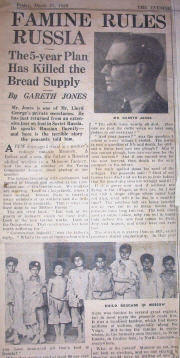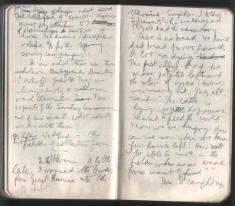 From the Times Online:
From the Times Online:
Millions of peasants were starving. Children were turned against adults as they were recruited to expose people accused of hoarding grain. Stalin sealed the border between Russia and Ukraine to ensure that news of the famine would not spread, but one journalist was able to break through to discover the truth.
Gareth Jones, who revealed the story of the forced famine that claimed the lives of four million people in Ukraine in the 1930s, recorded the words of Stalin’s victims in his diaries, which he then used to prepare his dispatch.
The public can see the diaries for the first time today as they go on display at the University of Cambridge.
One entry from March 1933 describes how Jones illegally sneaked across the border from Russia to interview peasants. “They all had the same story: ‘there is no bread; we haven’t had bread for two months; a lot are dying’,†he wrote.
…
Despite his first-hand account of the starvation, the story of what has become known as the Holodomor (Ukranian for “the famineâ€) was not widely followed because it was disputed by other Western journalists based in Moscow who wished to placate their contacts. Walter Duranty, a British-born correspondent for The New York Times, opined that Jones’s judgement had been “somewhat hastyâ€. He suggested that Jones had a “keen and active mind†and that his 40-mile trek near Kharkov had been a “rather inadequate cross-section of a big countryâ€.
…
Jones’s relatives, who discovered his diaries in the 1990s, believe that his kidnap in China may have been arranged by Soviet spies. David Lloyd George, who consulted Jones on foreign affairs after he stepped down as Prime Minister, hinted that Jones was killed because of something he knew. The diaries, which are on display at the Wren Library, Trinity College, Cambridge until mid-December, lay forgotten for more than 50 years.
Scans of his diary are available online at his memorial website. More from the University of Cambridge:
Now, for the first time, the diaries that Jones kept as he trekked across Ukraine and used as the basis of his reports are being put on display by Trinity College, University of Cambridge, where he was a student.
The documents have been kept by his family and are going on show to coincide with a new, feature-length documentary about Jones and the famine by the director Serhii Bukovs’kyi. The film, called “The Living”, will receive its British premiere on Friday (November 13th) as part of the Second Annual Cambridge Festival of Ukrainian Film, organised by the University’s Department of Slavonic Studies.
“These diaries are the only independent Western verification of what was arguably Stalin’s greatest atrocity,” Jones’ great nephew, Nigel Linsan Colley, said.
“Jones was the only journalist who risked his name and reputation to expose Holodomor to the world,” Rory Finnin, Lecturer in Ukrainian Studies at the University of Cambridge, added. “His diaries are a stirring historical record of an often forgotten tragedy of the 20th century.”
…
Gareth Jones’ diaries will be displayed at the Wren Library, Trinity College, Cambridge, from November 13th to mid-December. The library is open at specific times during the week. For details, visit:Â http://www.trin.cam.ac.uk
Much of Gareth Jones’ life has been documented online at his memorial site and is a great resource with lots of information. As we are approaching Holodomor Memorial day, please take some time to read about the works of his 29-year old life and it’s great importance to Ukrainians and the Holodomor.

Great post Andrew, I will link to your post later when I do my updated on the blog. Roman
Great post Andrew, I will link to your post later when I do my updated on the blog. Roman
Nice article.I love this post.
Bathmate